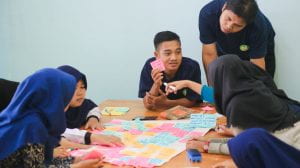Snapshot
Type of Interaction: Student with student, student with content
Type of Course: Online
LMS Used: TRACS (any)
Tools Used: Forums, Discussion
Credit
Joellen Coryell, Adult, Professional, and Community Education
One of our recent articles, Student Voices: What Makes an Effective Online Course, sparked some lively discussion on our online teaching listserv. The article included a description of student led discussions for an online course. A small group of students created 3-4 activities and related discussions to enhance the week’s lesson.* Activities consisted of watching a Ted Talk, considering a case study, reviewing a professional instrument, etc. The group also posed a discussion prompt for their peers and moderated the discussion.
You might not be surprised to learn that these are doctoral students. They were a cohort for 8 months prior to the course. And they are adult education students with a professional interest in facilitating discussions well.
On the listserv, some opined that student led discussions only work for doctoral students, for students who know each other well, or students motivated to better facilitate discussions. I wanted to know more. Was this really a unique case? Or could student facilitated discussions work for other groups of students? I asked the instructor of the course, Dr. Joellen Coryell, Professor of Adult, Professional, and Community Education.
Key Details
Dr. Coryell explained the essential parts of student led discussion. She recommends:
- Communicate your expectations very clearly, completely, and repeatedly.
- Model what a quality set of activities and discussions looks like for a lesson or two.
- Save time for groups get to know each other and coordinate roles and expectations.
- Segment the lesson*:
- 3 days – Read/watch the content.
- 3 days – Class-wide discussion
- 1 day – Instructor posts a reflection, wrap-up, and preview of what’s next
- The facilitating group should create:
- An overview presentation of the content to frame discussion.
- An appropriate number of activities/discussions which engage the content and real life.
- The facilitating group ensures continuing discussion by asking clarifying questions, requesting examples or resources, offering positive feedback, etc.
Note the constructivist approach, the use of dialogue, active learning, and small group to large group dynamics.
Broadening the Design
This is certainly a sophisticated approach, but with proper preparation and scope, Dr. Coryell has no doubt it can work for all students. The key is to require the right number of activities/discussions and to give students enough time to prepare for success. Here are some guidelines for the number of activities:
- Undergraduates: Presentation + 1 activity
- Master’s students: Presentation + 2-3 activities
- Doctoral students: Presentation + 3-4 activities
For students to succeed, they need to establish group norms and develop clarity about the expectations. Plan time and assignments for groups to get to know each other, set roles, choose how to collaborate, and create a conflict resolution plan. Meanwhile, reinforce your expectations with models of good activities, clear instructions, and rubrics. Hold a course-wide discussion about what engaging discussion looks like. How do you write an engaging post? What pulls you into a discussion? What energizes you to discuss? Students need more time, models, and guidance the younger they are and the less well they know each other.
- Undergrads: 2+ weeks
- Graduate students: 1-2 weeks
- The doctoral students above: less than a week to create norms.
Key Moments for Communication
If you decide to try student-led discussion, over-communicating expectations is key. Here are some tips for when and where to consider:
- Explain why you chose student led discussion as a learning activity; because students learn more deeply and apply learning when they actively discuss and practice new content.
- Include your clear and complete expectations in the:
- Syllabus
- Introductory emails or announcements
- Start Here or Getting Started page
- Rubrics
- Instructions
- Model the finished product.
- Pay close attention to the facilitators while they are planning. Redirect them early if they’re off track.
- Contact students who aren’t discussing enough to clarify your expectations.
- Participate judiciously in the discussions. Add clarification, correction, or enhancements where necessary, but try to allow the conversation to unfold naturally. Dr. Coryell’s 9 students made over 200 posts per week, so don’t overdo it.
- Wrap up the discussion with a summary, praise for good work, and preview of what’s next.
I hope you try it and good luck.
* * *
*Disclaimer: The numbers in the prose reflect what Dr. Coryell recommends for student led discussion after reflecting on her experience teaching ADED 7318. Here’s the comparison of her field test with her recommendation. The changes decrease the amount of time actively discussing to balance the workload for the instructor and students.
- Number of activities
- Tested: 4-5
- Revised: 3-4
- Lesson segments
- Tested: 3 days reading and activity planning, 4 days discussion
- Revised: 3 days reading and activity planning, 3 days discussion, 1 day instructor post
